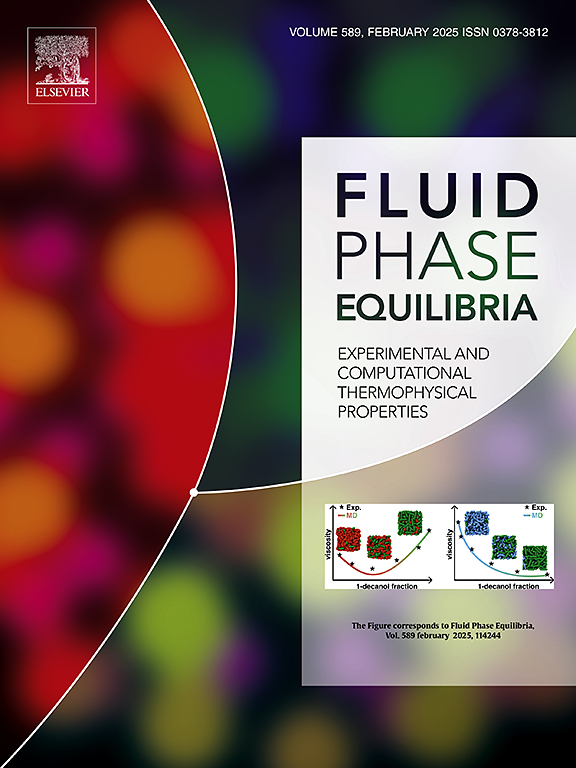Developing a fast estimation method for the pH in aqueous solutions made of ILs with protic constituents: The case of choline with amino acid and peptide anions
IF 2.7
3区 工程技术
Q3 CHEMISTRY, PHYSICAL
引用次数: 0
Abstract
This work aims to provide simple and fast estimations for the pH of protic Ionic Liquids (ILs) solutions, particularly for those constituted with choline cation ([Ch]+) and Amino Acid (AA) or Peptide (Pep) -based anions. pH calculation based on the pKa of pILs are typically carried-out with a posteriori, after synthesis and measurement, or a priori procedures, through quantum chemical calculations. Here, we adapt the isoelectric point (pI) concept to perform a straightforward pH estimation for an aqueous solution of pILs using the pKa from their parental ions. Moreover, a library of pH values for 1 M aqueous solution of 14 different in-house synthetized ILs based on AA and Pep is presented, including the first (pH, FTIR and TGA) characterization of some of those solvents. Following the pI approach and using the pKa of the parental ions, the pH of a 1 M aqueous solution of these ILs has been predicted with suitable accuracy (RMSD ≈ 0.5 units of pH), fulfilling the main estimation purposes of this work. Despite the tabulated pKa of each molecule being a more suitable input, software able to deploy fast pKa predictions may be used as well, especially when no experimental values are available, but one must be aware that some systematic errors may appear. In summary, we present a fast and straightforward method able to simplify the pH prediction of pIL aqueous solutions, a matter that can be key in the design of IL-based technologies.
建立一种快速测定含有质子组分的胆碱水溶液pH值的方法:以胆碱与氨基酸和多肽阴离子为例
本工作旨在提供简单快速的估算质子离子液体(ILs)溶液的pH值,特别是那些由胆碱阳离子([Ch]+)和氨基酸(AA)或肽(Pep)阴离子组成的溶液。基于pKa的pH计算通常是在合成和测量后,或通过量子化学计算的先验程序进行的。在这里,我们采用等电点(pI)概念,使用来自它们的亲本离子的pKa对pILs水溶液进行直接的pH估计。此外,本文还建立了基于AA和Pep的14种不同内部合成的il的1 M水溶液的pH值库,并对其中一些溶剂进行了首次(pH、FTIR和TGA)表征。采用pI方法,利用亲本离子的pKa,以合适的精度(RMSD≈0.5单位pH)预测了这些il的1 M水溶液的pH,满足了本研究的主要估计目的。尽管每个分子的pKa表是更合适的输入,但能够快速部署pKa预测的软件也可以使用,特别是在没有实验值的情况下,但是必须注意可能会出现一些系统误差。总之,我们提出了一种快速而直接的方法,能够简化pIL水溶液的pH预测,这可能是基于il技术设计的关键问题。
本文章由计算机程序翻译,如有差异,请以英文原文为准。
求助全文
约1分钟内获得全文
求助全文
来源期刊

Fluid Phase Equilibria
工程技术-工程:化工
CiteScore
5.30
自引率
15.40%
发文量
223
审稿时长
53 days
期刊介绍:
Fluid Phase Equilibria publishes high-quality papers dealing with experimental, theoretical, and applied research related to equilibrium and transport properties of fluids, solids, and interfaces. Subjects of interest include physical/phase and chemical equilibria; equilibrium and nonequilibrium thermophysical properties; fundamental thermodynamic relations; and stability. The systems central to the journal include pure substances and mixtures of organic and inorganic materials, including polymers, biochemicals, and surfactants with sufficient characterization of composition and purity for the results to be reproduced. Alloys are of interest only when thermodynamic studies are included, purely material studies will not be considered. In all cases, authors are expected to provide physical or chemical interpretations of the results.
Experimental research can include measurements under all conditions of temperature, pressure, and composition, including critical and supercritical. Measurements are to be associated with systems and conditions of fundamental or applied interest, and may not be only a collection of routine data, such as physical property or solubility measurements at limited pressures and temperatures close to ambient, or surfactant studies focussed strictly on micellisation or micelle structure. Papers reporting common data must be accompanied by new physical insights and/or contemporary or new theory or techniques.
 求助内容:
求助内容: 应助结果提醒方式:
应助结果提醒方式:


